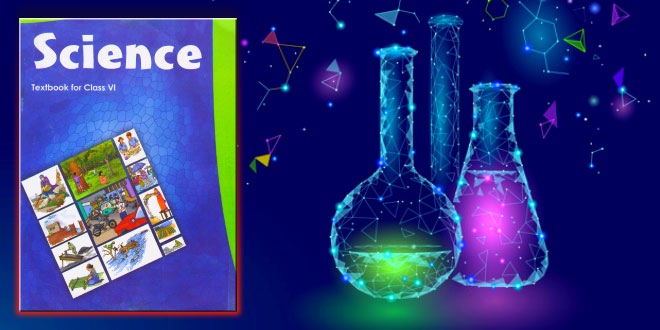Air Around Us – 6th Class NCERT CBSE Science Chapter 15
Question: What is the composition of air? or Write a short note on the composition of air.
Answer: Air is mixture of nitrogen, oxygen, carbon dioxide, water vapour and a few other gases. Some dust particles may also be present in it.
Air is a mixture of gases, mainly containing nitrogen (about 78% by volume) and oxygen (about 21% by volume). The remaining 1% is made up a gas called argon (about 0.9%), Carbon dioxide (0.03%) and small amounts of other gases. Varying quantities of dust, smoke and water vapour are also presents. The amount of these in the air varies from place to place and from time to time.
Air Around Us – Question: Which gas in the atmosphere is essential for respiration?
Answer: Oxygen
Question: How will you show that air supports burning?
Answer: Take a small burning candle. Cover the burning candle with a glass jar. After few minutes the candle is extinguished. As the supply of air is stopped due to glass jar the burning of candle is also stopped. This experiment proves that air supports burning.
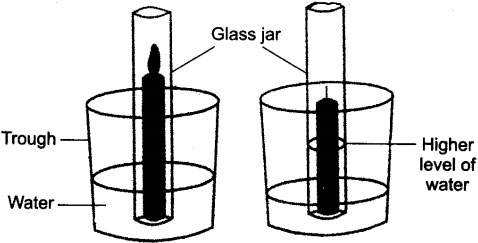
Question: How will you show that air is dissolved in water?
Answer: Take some water in a glass vessel or beaker. Heat it slowly on a tripod stand. Before the water begins to boil, look carefully at the inner surface of the vessel. You will see tiny bubbles on the inside. On heating, air dissolved in water escapes in the form of these bubbles.
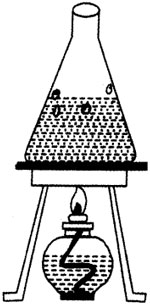
Air Around Us – Question: Why does a lump of cotton wool shrink in water?
Answer: Lump of cotton wool has air among gaps of cotton fibres. When water replaces the air from these gaps, the cotton lump becomes heavy and also shrinks due to removal of air gaps.
Question: List five activities that are possible due to presence of air.
Answer: The activities that are possible due to the presence of air are:
- To make a simple firki
- To make a weather cock
- To breathe for survival
- For burning of substance
- For photosynthesis
Question: How do plants and animals help each other in exchange of gases in the atmosphere?
Answer: Animals and plants use oxygen from air during respiration and release carbon dioxide gas in air. But green plants also release oxygen gas by using carbon dioxide during photosynthesis. Thus, we can say that animals and plants help each other in exchange of gases.
Question: Name the main component of air.
Answer: Nitrogen gas
Question: What is the source of oxygen gas in air?
Answer: Photosynthesis by green plants is source of oxygen gas in air.
Question: What is the percentage of nitrogen in air?
Answer: 78.1%
Question: What is the percentage of oxygen in air?
Answer: 20.9%
Question: What is the source of carbon dioxide in air?
Answer: Respiration by animals and plants and burning of fuel.
Question: Mention one necessary condition for the combustion to take place.
Answer: Presence of air.
Question: Why is air considered as a mixture?
Answer: Air contains oxygen and nitrogen as its major constituents of air. These gases retain their properties in air. So the air is called a mixture.
Question: Name the major gas present in the (a) inhaled air (b) exhaled air.
Answer: (a) Oxygen (b) Carbon dioxide.
Question: Write the necessary conditions for rusting of iron to take place.
Answer: Rusting of iron takes place in the presence of moisture and air. So the presence of air and water vapour in air are two necessary conditions for rusting of iron.
Question: Name a device which uses wind energy to generate electricity.
Answer: Windmills use the wind energy to convert wind energy into electrical energy
Question: What is wind energy? Mention its two advantages.
Answer: Blowing air is called wind. Wind possesses kinetic energy. The kinetic energy possessed by wind is called wind energy.
Uses of Wind Energy are:
- Wind energy is used to pump the ground water.
- Wind energy is used to generate electricity with the help of windmills.
Air Around Us – Question: Mention two uses of air.
Answer: The two uses of air are as below:
- For respiration all organisms need air.
- For burning of any substance air is needed.
Question: Describe balance of oxygen in the air.
Answer: The oxygen in air is used by the organisms present in air, water or soil or on earth for their respiration. During respiration carbon dioxide gas is released to air. But green plants during photosynthesis use carbon dioxide of air for preparing food and they release oxygen gas in the air. Thus the balance of oxygen in air is maintained.
Question: What happens if the percentage of oxygen in the air reaches to 70%?
Answer: If any substance catches fire it will become difficult to extinguish the fire, as oxygen supports combustion.
Question: What happens if the percentage of carbon-dioxide increases in the air?
Answer: The increased percentage of carbon-dioxide will cause green house effect, i.e. it will not allow the hot rays of sun to escape from the atmosphere after reflection once they enter the earth’s atmosphere, thereby increasing the temperature of earth, ice on mountains will melt and water level will rise.
Question: You must have seen during rainy season, when it rains the animals like earthworm, snakes, snails etc. are commonly seen. Explain why?
Answer: All these animals live in underground burrows or remain buried in the soil. They get oxygen from air that enters into the burrow through entrance of burrow or through pores in the soil. But when it rains, the water gets filled in their dwelling places and pores of the soil. So, they come out in search of air.
Question: Why is carbon-dioxide gas used to extinguish fire?
Answer: It is because carbon-dioxide does not support combustion. When sprayed on burning object it stops the supply of oxygen and extinguishes fire.
Question: How will you prove that soil contains air in it?
Answer: Take a glass tumbler add some soil in it, then pour some water on the soil slowly, the air-bubbles comes out of the soil. This proves that soil holds air in it.
Question: Why do we see the sky and air clear and clean after rainfall?
Answer: The dust particles which remain suspended in air get loaded and come down on the ground due to rainfall, this is the reason that the sky and the air look clean and clear after rainfall.
Question: Explain why mountaineers carry oxygen cylinders with them?
Answer: As you go up, above the sea-level the atmospheric pressure goes on decreasing and the amount of oxygen also decreases at higher altitude.
Question: Explain why during an incident of fire, one is advised to wrap a woollen blanket over a burning object.
Answer: Blanket cuts the supply of oxygen to the object that is burning, thereby prevents it from further burning.
Question: What is air? Name the major constituents of air. Also give their volume proportions in air.
Answer: Air is a mixture of gases. The major constituents of air are nitrogen, oxygen, carbon dioxide and argon. The percentage composition of constituents of air are as given below:
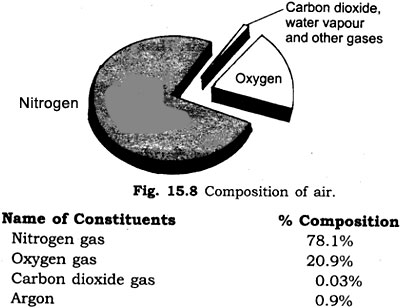
Other components of air are water vapour and dust particles.
Question: Demonstrate through a simple experiment that the air mainly contains nitrogen and oxygen in the volume ratio of 4:1.
Answer: Aim of experiment: To show that air contains nitrogen and oxygen in the ratio 4:1 by volume:
Procedure: Take a glass container and fix a candle at its centre. Put some quantity of water in the container. Place an empty, dry gas jar over it. Mark five marks above water surface on the jar at equal distances shown in the figure given below.

The candle is lightened and is covered with the gas jar. After some time the candle is extinguished and the water level is raised in gas jar. The raised level in water is 1/5 of the volume of air in the gas jar.
This proves that one part of the air of the jar is a gas which supports combustion, i.e., oxygen. Hence, 1/5 by volume is oxygen in air.
Air Around Us – Question: Air is a mixture. Prove this statement.
Answer: The components of mixture can be easily separated and they retain their properties.
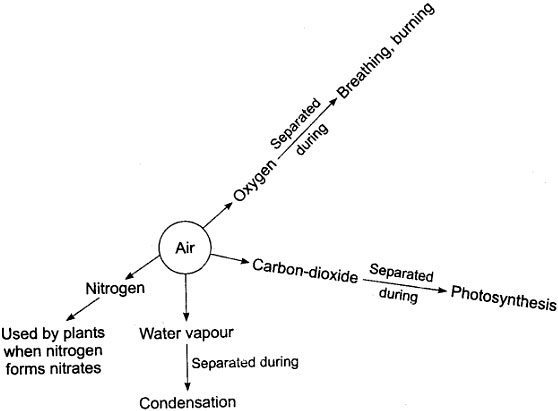
The components of air are: oxygen, nitrogen, water vapour and carbon-dioxide, all these gases can be easily separated and they retain their properties.
Question: What do you mean by ‘atmosphere’?
Answer: A blanket of air surrounding the earth is called the atmosphere. It extends up to about 1000 km above the surface of the earth.
Question: Carbon dioxide is present to the extent of only 0.03% by volume in air. Why then is it considered to be so important?
Answer: Air contains very title carbon dioxide – only 0.03%. However, it is a very crucial component of air.
Question: What is humidity?
Answer: The amount of water vapour present in the air is known as humidity.
Question: What is the difference between breathing in and respiration?
Answer:
- All living things breathe in oxygen.
- Living things need energy all the time for various life process, they need to breathe in oxygen all the time.
- The process of breathing in, getting energy from food and breathing out is called respiration.
Question: Do plants require nitrogen? Why?
Answer: Nitrogen is required by plants for their growth. But plants are not able to absorb the nitrogen directly from the air. Nitrogen in the air is brought to earth in the from of nitric acid through lightning and rain. Soil changes it to nitrate compounds which is absorbed by the plants. Also, nitrogen in the air is used by us to manufacture fertilizers.These fertilizers again provide the essential nitrogen to plants.
Question: What is the importance of the ozone layer in the atmosphere?
Answer: The upper atmosphere contains a layer of gas called ozone. It prevents harmful rays of the sun from reaching the earth. These rays, called ultraviolet rays, can cause eye problems and skin cancer.
Question: How do fish breathe?
Answer: Fish, breath in oxygen dissolved in water. Fishes have organs called gills, oxygen dissolved in the water is absorbed.
Question: Why is it considered unhealthy to breathe in through the mouth?
Answer: Dust and smoke in the air are harmful for our respiratory system. Fine hair and mucus present in our nostrils filter them out and prevent them from getting into our respiratory system. That is why it is unhealthy to breathe through our mouth.
Question: What is the oxygen cycle?
Answer: The natural cycle of consumption of oxygen by respiration and burning and its release by photosynthesis is called the oxygen cycle.
Question: list the uses of air.
Answer: Besides breathing, air is useful to us in many other ways.
- The wind makes windmills rotate. The windmills are used to draw water from tube wells and run flour mills. It is now being widely used to generate electricity.
- Aeroplanes, helicopters, balloons, parachutes and yachts work because of air.
- Birds, insects and bats are able to fly because of the presence of air.
- Air helps in the dispersal of seeds.
- Air helps in pollination of several flowers.
- Air plays an important role in the water cycle.
Question: How does the atmosphere help to maintain the right temperature on the earth?
Answer: The atmosphere helps to maintain the right temperature on the earth. The heat and light of the sun fall on the earth’s atmosphere. Some of it is absorbed by the atmosphere, while the rest is reflected back. This prevents the earth from becoming very hot during the day. At night, the trapped heat in the atmosphere prevents the earth from cooling down too much. The atmosphere, thus, acts like a blanket around the earth and helps to keep the earth’s surface at the right temperature for life to exist.
Question: How is the balance of oxygen and carbon dioxide maintained in air?
Answer: The balance of oxygen and carbon dioxide in the atmosphere is maintained through respiration in plants and animals and by photosynthesis in plants. Plants produce oxygen during photosynthesis and utilize oxygen during respiration. They produce much more oxygen photosynthesis than they consume. During respiration this is how the oxygen consumed by plants and to a large extent by animals is replenished in the air through photosynthesis.
Question: Define pollution. How does air gets polluted?
Answer: The addition of substance in the environment in quantities that are harmful to living beings is called pollution. Air is getting polluted day by day because of various human activities:
- Burning of fuels like coal and petroleum, excessive burning of fuels like wood, smoke.
- Harmful gases released from industries.
- Smoke released by vehicles and machines releasing gases are the major causes of air pollution. These gases spread and mix in the air and spoil the quality if air, thereby making it impure.
Question: What are the major effects of air pollution on plants and animals?
Answer: Air pollution has major adverse effects on plants, animals as well as human beings. Harmful gases present in the polluted air make breathing difficult. Air pollution also leads to a lot of lung disease like asthma and lung cancer. Air pollution also damages crops.
Question: Name some of the ways by which we can reduce air pollution.
Answer: There are a number if ways by which we can reduce air pollution. Some of them are: Planting more and more trees, recycling plastics, regular checking of vehicles for emission of harmful gases etc.
 Class Notes NCERT Solutions for CBSE Students
Class Notes NCERT Solutions for CBSE Students
